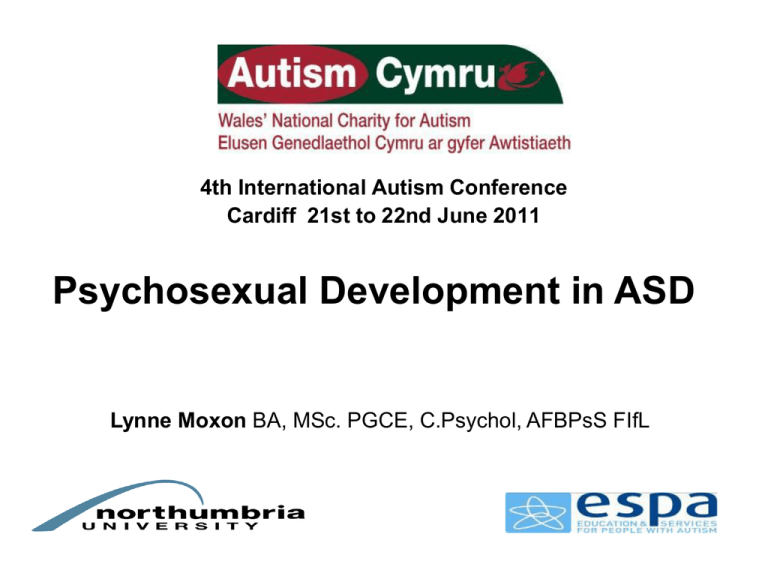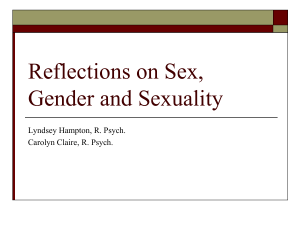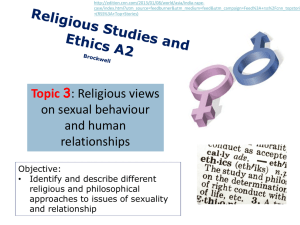
4th International Autism Conference
Cardiff 21st to 22nd June 2011
Psychosexual Development in ASD
Lynne Moxon BA, MSc. PGCE, C.Psychol, AFBPsS FIfL
• Sexual development and curiosity are
normal developmental processes
• Bolton (2006) argues that difficulties
in sexual experience, sexual
expression and relationships are
inevitable given the core deficits in
Autism Spectrum Disorders.
• Key milestones of adolescent
development include attaining an
adult body capable of reproducing,
having and maintaining intimate
relationships, managing a range of
complex emotions, and independently
thinking and problem solving.
Psychosexual development of
children and young people
• There is a lack of literature on
childhood sexuality
• Little is known about 'normal sexual
development'
• Sexual behaviors are common in
children. More than 50% of children
will engage in some type of sexual
behaviour before their 13th birthday
• (Gil and Cavanagh-Johnson, 1993; Ryan and Lane, 1997 Kellogg
2009)
3-6 years
Focus on developmental level rather than age when assessing behaviour
Sexual (social)
development
Sexual Behaviour
Sexual
Knowledge
Autism Spectrum
Children grow; boys‘
testicles descend;
Peer exploration;
Erections and lubrication
for boys and girls;
May drop their close
attachment to their
opposite-sex parent and
become more attached
to their same-sex parent;
Peer rather than adultoriented; intensely
interested in forming
friendships
Touch their own and others (peers)
genitals.
Look and play doctor, nurses,
mum/dad games with peers;
Masturbation continues to be
common, experience
pleasurable feelings;
Interest in own faeces, and
watches others use the toilet
and bathroom.
Show genitals to others;
Rubs genitals, masturbates, when
uncomfortable, unhappy, tense,
upset, excited or afraid;
Viewing/touching peer or new
sibling genitals; Trying to view
peer/adult nudity
Girls, show increased awareness of
social norms regarding sex nudity,
and privacy;
Language develops.
Become inquisitive and
verbal about some adult
sexual functions without
understanding.
Limited knowledge about
where babies come from.
Recognise gender
differences as they age.
Child asks about genitals,
intercourse.
Can name body parts more
accurately.
Use of slang words for
toilet/bathroom functions,
genitals and sex. Little
understanding of sex.
Limited language for body parts, lack
of curiosity about others behaviour.
No friends to play doctor and nurse
May not recognise gender difference
Interest in own faeces, may smear.
Interest in /fear of the toilet and
bathroom.
May be difficult to toilet train.
May masturbates (stimulates) self
excessively
Little awareness of social norms
regarding sex, modesty, nudity, and
privacy
More adult than peer-oriented;
Usual behaviours may not occur in ASD
because of the developmental lag and
the lack of understanding of what is
socially approved behaviour, personal
boundaries, impulse control, and
understanding what is hurtful or
uncomfortable to others.
• The sexual behaviour of young people can be
seen on a continuum from mutually agreed
experimentation to very serious crimes such as
stalking and rape.
• Many children engage in activities that form a normal
part of their sexual development.
Sexual experiences before 13 years of age73% recalled engaging in sexual behaviours with other children,
34% recalled showing their genitals to another child,
16% recalled simulating intercourse with another child
5% recalled inserting an object in the vagina or rectum of another child.
• Much of this behaviour is not abusive and forms
an important and necessary part of the learning
process. Other types of behaviour are harmful
and not appropriate. You can be put on the
sexual offenders register at 14.
• Experimenting at an increasingly
young age
• Knowledge of age-appropriate sexual
behaviours that vary with situational
and environmental factors can assist
in differentiating normal sexual
behaviours from sexual behaviour
problems.
• Sexuality of individuals with ASD has
been little studied.
• The physical and emotional changes that occur
in adolescence are part of the process of sexual
maturity. A young person with ASD’s
psychological and social maturity does not keep
pace with their physical maturity irrespective of
ability.
• The specific nature of ASD has inherent
limitations in the area of social awareness as a
defining element making the achievement of
personal sexual identity much more complex.
(Tissot 2009)
• Despite these inherent limitations, people with
autism will be interested in discovering a
personal sexual identity and in establishing
sexual relationships with others (Tarnai and Wolfe, 2008).
Where do we start?
1. Public, Private, Personal Space
2. Teach the rules
3. Give information
4. Do not encourage behaviour which
would later be interpreted as sexual.
Public, Private, Personal
Space
Personal space
• By not seeing that a child is growing toward
adulthood, parents may not feel moved to begin
teaching boundaries.
• Most of the incidents which lead to trouble for
young people with developmental difficulties,
autism or learning difficulties are "boundary
violations" brought on by the impulse of a
moment.
• How would you manage your sexuality if you
had no sex education, could not ask/talk to
anyone and did not have access to books or
other written or visual material?
Teach the rules…..
• Structure is important for people with ASD.
If you did not know the rules for social
situations you would be anxious.
• Consistency is important but social rules
are flexible
Rules, information, communication
Is this Public or Private
behaviour?
5 point scale 5 4 3 2 1
5 4 3 2 1
5 4 3 2 1
5 4 3 2 1
5 4 3 2 1
Social rules change with age
and place
Will I get into trouble?
• Young people are increasingly bombarded by
sexual images and there is an increase in
casual sex.
• 70% of children,12 to 15 report unintended
exposure to porn websites
• 58% of teenagers view porn regularly
• Boys may be pressurised into having sex
• Girls use porn to measure their sexual
performance (63% of girls aspire to be glamour
models)
• There is a dangerous lack of knowledge about
STIs
• Sexualisation is the imposition of adult
sexuality on to children and young people
before they are capable of dealing with it,
mentally, emotionally or physically.
Sexualisation of Young People Review
Home Office 2010
• In addressing these
issues we must not
forget that sexual
curiosity is a normal
feature of childhood
and therefore we
need to provide
young people with the
tools that will enable
them to deal with
sexual content safely
and successfully.
• Key milestones of adolescent
development include attaining an adult
body capable of reproducing, having and
maintaining intimate relationships,
managing a range of complex emotions,
and independently thinking and problem
solving.
Sexual images and pornography
• Over the past three decades there has been a
dramatic increase in the use of sexualised
imagery in advertising.
• While most of this imagery features women,
there has also been a significant increase in the
number of sexualised images of children.
• Home Office : “It is no longer a case of if a
young person will be exposed to pornography
but when.”
Shades of blue. Calvin Klein uses an
image of group sex to sell jeans
• The world is
saturated by more
images today than
at any other time
in our modern
history. Behind
each of these
images lies a
message about
expectations,
values and ideals.
The Influence And Impact Of
Pornography On Young People
•
•
•
•
•
•
•
Hardcore material is widely available on the internet
with 25%of all searches seeking access to one of the
1.3 million porn websites.
Among young people with at least weekly internet use,
57% reported having come into contact withonline
pornography(for one third this was an accidental
occurance whilst searching for something else)
70% of young people aged 15-17 report unintended
exposure to pornography
58% of teenagers view porn regularly
1 in 10 view it every day
Online porn is where most is viewed
The average age that males start to access porn is
10/11
CASE STUDY
• Charlie is 16 years old and has been collecting
abusive images of children. Charlie gave his
mother the impression he was being groomed
on the internet and he had little understanding of
the danger of downloading such pictures. To him
like were like his Pokemon collection of cards
and ‘they can’t be against the law or they would
not be allowed on the internet’.
• How might this have been addressed earlier?
• Can you think of any suggestions to help
Charlie and his parents?
• “almost everything he knew about sex he
had learnt from explicit websites. Perhaps
unsurprisingly, when it came to making
love to a real person, someone he cared
about, he had no idea how to behave. “
• I also had very high expectations of what a
girl would be like from all the porn I’d
watched.”
Issues of development -Henault
• Sexual behaviours: self-stimulation,
exploring sexuality
‘I want to get married because I would not have to masturbate anymore
and I would have someone to do the laundry.’
• Frustrations and inappropriate behaviours
‘Infatuation with a woman at work got me fired.’
• Gender identity & role definition: « My way »
– flexibility, conflict, confusion
‘Why do you love her? Because she’s clever, organised and good at
filling in forms.’
• Social imitation: context, consent
She seemed interested in me. I got married because I thought that’s
what people are supposed to do’.
Issues of development
• Interpretation of emotions: black & white.
‘Sex is physical and does not require emotional feelings for a person.’
• Interpersonal relationships: couples,
empathy, intimacy.
‘For most of my life I didn’t realise what the word intimacy means: now I
have learned, I have to admit it sounds most unpleasant and unnatural.’
• Confusion & anxiety, deception
I had an affair…which almost broke up my marriage. I enjoy attention
from all ladies and my wife gets mad about this.’
Sexual drive, desire, curiosity
‘On my first time I would be curious to compare the parts of the breasts
and vulva with what I have had to teach myself on Wikipedia’
Sensory issues
• I don’t like somebody trying to hold me. I’ll
kiss her but only because she wants me to
(AS male)
• Could never come close to a smoker or
drinker (AS male)
• Smell – love it (AS male)
• I can’t come close to a partner with ant
real defects. I don’t like the nitty gritty
contact with the others body (AS male)
Inappropriate or deviant
behaviour?
• Hypermasturbation: Haracopos &
Pedersen (1992); Hellemans (2001)
• Wing (1975): masturbation in public
occurs.
• DeMyer (1979): masturbation in public;
inappropriate touching.
• Gillberg (1983): undressing and
masturbation in public, inappropriate
touching.
• Talking inappropriately about sex,
inappropriate person-oriented
behaviour) occurs quite often.
• Little data on prevalence of deviant
behaviours in normal population or
population with other developmental
disorders.
Reasons for Masturbation
•
•
•
•
•
Pleasure.
Obsessive or compulsive
behaviour.
Boredom.
Lack of alternative activity.
Stress.
Considerations
•
•
•
•
•
•
•
•
Is it masturbation?
Do they know the
appropriate place to
masturbate in each
environment?
Do they know when the
appropriate time is to
masturbate?
Will redirection work?
Can distraction work?
Is the person bored?
Look at physical exercise
programmes
Check medication
Gender identity
• Gender dysphoria is a condition where a
person feels that they are trapped within a
body of the wrong sex
• Prof Ina Van Berckeloer-Onnes – over
representation in ASD
• 7.8% in her client group with ASD have
Gender ID 7x more than general pop.
Netherlands.
• I was born in the wrong body – change it.
Fetish behaviour
• Sexual fetishism is the sexual arousal
brought on by any object, situation or body
part not conventionally viewed as being
sexual in nature.
• The use of objects and specific stimuli
could be related to a lack of imagination
(Haracopos & Pedersen, 1992).
• Use of objects in some cases meets
criteria for DSM-IV diagnosis of fetishism.
• Inappropriate behaviours might be a
sexual expression of the restricted,
repetitive and stereotyped pattern of
behaviour (Hellemans, 1996).
• -preoccupation with objects
• -sexual themes as stereotyped pattern of
interest
• -ritual sexual behaviour
Relationships
• Early social experiences play a critical role
in the psychosexual development of
children and adolescents and will be
limited or qualitatively different when an
autism spectrum disorder is present.
• How can you move onto intimate
relationships if you have never had a
friend?
CASE STUDY
• A 13 year old female student with AS
follows male mainstream students at
lunchtimes, to engage in social interaction.
(She is of a fairly large build and can be
quite flirtatious). Depending on the nature
of interaction, she can present with a
verbal and physical manner. She believes
that she has quite a few admirers,
unaware that the male students purposely
goad her believing her reactions are funny.
Theory of Mind
“ But they laughed, it
means they
enjoyed it.”
“ She didn’t say anything
so I can’t have upset
her”
CASE STUDY
• Students with AS have benefitted from assigned
Peer Support ‘buddies’, who support the
students in classroom and social situations.
Some female ‘buddies’ kindly offered for the
male students with AS to be their chaperons at
the school Prom (all aged 16 years). Difficulties
arising from this act of kindness include one
male student with AS then believed this female
‘buddy’ to be his girlfriend, whilst another male
student with AS said that if anyone tried to
dance with his female ‘buddy’, he would hit him.
Summary
• ‘Normal’ behaviour tends to be transient
and responsive to parental redirection or
admonishment.
• Sexual behaviour problems include
behaviours that are coercive, persistently
intrusive, injurious, and frequent; such
behaviour usually requires
assessment of familial and situational
factors and treatment beyond parent
redirection.
Promoting development
• It is important to encourage the
development of self esteem
• All children feel better about themselves
and are more readily accepted by peers
when provided with stylish and ageappropriate clothing
• Social development is largely experiential,
and children with ASD generally have
fewer opportunities for social interactions
than their typically developing peers.
• Promoting typical teenage activities, such
as going shopping or the cinema with
peers or participating in social activities at
school, may require extra parental
planning but afford invaluable
opportunities to develop social skills.
• It is difficult to develop an intimate
relationship if you have never had a friend.
• By mastering appropriate greetings,
eye contact, body language, issues of
personal space, self-advocacy skills, and
telephone and computer skills, children
build a strong foundation for the
development of more complex social skills.
• All individuals need to learn as a minimum
the basics of body parts, how they work
and safety (Gill and Hough, 2007)
• If their autism is severe, the content may
need to centre on masturbation and
establishing a sexual identity in a solo
manner (Cambridge et al., 2003).
Hellemans (2007)
• interest in sexual experience is usual
• sexuality is important for most individuals with
ASD.
• individuals with ASD should have the right to
fulfill their sexual needs;
-receive training in sociosexual behaviour
-have access to the sexual knowledge they can
manage
-have the right to express sexual impulses in a
socially acceptable way









